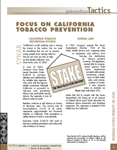Resources
 Whether you are a parent, community member, educator, policymaker, or prevention specialist, the resources listed in this section will help you plan and implement alcohol use prevention programs and stay up to date in the prevention field. Whether you are a parent, community member, educator, policymaker, or prevention specialist, the resources listed in this section will help you plan and implement alcohol use prevention programs and stay up to date in the prevention field.
 Prevention Tactics. Prevention Tactics.
http://www.ca-cpi.org/Publications/publications_main_page.htm
An assortment of topics relating to binge drinking are addressed, with background information and strategies to address each issue. (Community Prevention Initiative [CPI])
Prevention Tactics topics include the following:
 Technical Assistance Research Publications. Technical Assistance Research Publications.
http://www.ca-cpi.org/TARP/index.htm
Targeted towards underage and hazardous drinking, these publications provide background information and practical knowledge for applying some of the most promising strategies available to the field of prevention. (Community Prevention Initiative [CPI])
Topics include the following:
 Tips for Parents: Underage Drinking in California Tips for Parents: Underage Drinking in California
What Can You Do?
As a parent or caregiver, you have vital influence on the life of your child. You serve as a role model on the use of alcohol, control the availability of alcohol in your home, and help set your child’s expectations concern-ing drinking behaviors. Use the information described here, and in the full Tips for Parents: Underage Drinking in California publication, to help prevent the youth you know from drinking underage.
Developed by the California Governor’s Prevention Advisory Council’s Underage Drinking Prevention Workgroup. If you would like a hard copy of “Tips for Parents…” or to inquire about making the booklet state specific, contact Wendy Tully of the California Attorney General’s Office at wendy.tully@doj.ca.gov.
Tips for Parents:

Additional Resources:
Alcohol and the Adolescent Brain.
http://www.duke.edu/~amwhite/Adolescence/index.html
A brief discussion of recent findings regarding adolescent substance use, adolescent brain development, and the impact of alcohol on adolescent behavior and brain function. (Duke University)
Alcohol Compliance Checks Procedures Manual.
http://www.epi.umn.edu/alcohol/manual/manual.pdf
A practical guide for public officials, law enforcement officers, and alcohol-regulation agents who are developing and implementing a compliance check system for establishments that sell or serve alcohol. (Alcohol Epidemiology Program, University of Minnesota)
Alcohol Cost Calculator for Kids.
http://www.alcoholcostcalculator.org/kids/
A web-based application that allows communities to arm themselves with locally-relevant data on the extent of serious drinking problems and alcoholism among adolescents. The tool was created to help parents, teachers, and law makers calculate the toll of alcohol problems in their community. (George Washington University Medical Center)
Alcoholism: Getting the Facts.
http://pubs.niaaa.nih.gov/publications/GettheFacts_HTML/Facts.pdf
This guide is designed to help individuals and families answer questions about alcohol problems. It contains information on alcoholism and alcohol use, the symptoms of each, when and where to seek help, treatment choices, and additional resources. (National Institute on Alcohol Abuse and Alcoholism [NIAAA])
Alcohol’s Damaging Effects on the Brain.
http://pubs.niaaa.nih.gov/publications/aa63/aa63.htm
This Alcohol Alert reviews some common disorders associated with alcohol–related brain damage and the people at greatest risk for impairment. It looks at traditional as well as emerging therapies for the treatment and prevention of alcohol–related disorders and includes a brief look at the high–tech tools that are helping scientists to better understand the effects of alcohol on the brain. (National Institute on Alcohol Abuse and Alcoholism [NIAAA])
Athens-Clark County (Georgia) Police Department: Case Study of an Effective and Comprehensive Youth Alcohol Enforcement Initiative.
http://www.udetc.org/documents/LeadershipandNetworkingAthens.pdf
This case study presents an example of how youth alcohol enforcement can be achieved through a continuous, yet low-cost and low-maintenance, community effort spearheaded by the local police executive. (Underage Drinking Enforcement Training Center [UDETC])
A Call to Action: Changing the Culture of Drinking at U.S. Colleges.
http://www.collegedrinkingprevention.gov/NIAAACollegeMaterials/TaskForce/TaskForce_TOC.aspx
A comprehensive review of strategies to reduce drinking on college campuses. (National Institute on Alcohol Abuse and Alcoholism [NIAAA])
Campaign for Alcohol-Free Sports TV.
http://cspinet.org/booze/CAFST/
The Campaign for Alcohol-Free Sports TV seeks to reduce the amount of alcoholic-beverage advertising to underage children and young adults who tune into televised sports for fun. (The Center for Science in the Public Interest)
College Drinking: Changing the Culture.
http://www.collegedrinkingprevention.gov/
This online resource center was developed to address alcohol use among college students. The site's content is based on a series of reports published by the Task Force of the National Advisory Council on Alcohol Abuse and Alcoholism. In addition to the Task Force reports, the site includes frequently asked questions on alcohol abuse, college and university alcohol policies, and a special section for students. (National Institute on Alcohol Abuse and Alcoholism [NIAAA])
Community How to Guides on Underage Drinking Prevention.
http://www.nhtsa.dot.gov/people/injury/alcohol/Community%20Guides%20HTML/Guides_index.html
This series of guides advises local advocates on how to deal with the following issues: coalition building, needs assessment and strategic planning, evaluation, prevention and education, underage drinking enforcement, public policy advocacy, media relations, and self-sufficiency. (National Highway Traffic Safety Administration and Governor’s Highway Safety Association)
Community Indicators of Alcohol & Drug Abuse Risk: County Reports 2004.
http://www.ca-cpi.org/Publications/community_indicators_main_page.htm
This report compiles data on 26 community indicators, including measures of risk factors associated with alcohol and other drug use, measures of overall substance use prevalence, and measures of the consequences associated with problem use. Each indicator and its population-based rate is reported in six-year trends with state and county-level comparisons to allow for monitoring of changes in problem status over time and across geographic area. (Community Prevention Initiative [CPI])
Drinking In America: Myths, Realities, and Prevention Policy.
http://www.udetc.org/documents/Drinking_in_America.pdf
This paper provides a realistic picture of who drinks, how much, and how often. It compares the drinking patterns of adults to those of people under age 21. It then analyzes the implications of these drinking patterns for alcohol policy. (Office of Juvenile Justice and Delinquency Prevention [OJJDP])
Enforcing Underage Drinking Laws: A Compendium of Resources.
http://www.ncjrs.gov/html/ojjdp/compendium/2001/contents.html
This compendium is designed to assist states and localities with issues involving underage drinking. (Office of Juvenile Justice and Delinquency Prevention [OJJDP])
A Family Guide - Alcohol, Inhalants, Tobacco, Other Drugs and Our Youth.
http://www.lowefamily.org/communities/order.html
A 24-page booklet to help parents prepare their children between the ages of 9 and 12 for issues relating to alcohol, inhalants, and tobacco and other drugs they may face as pre-teens and teenagers. (Lowe Family Foundation)
A Family Guide - Alcohol, Tobacco, Other Drugs and Teenagers.
http://www.lowefamily.org/communities/order.html
A 32-page educational resource guide that helps both parents and students gain a better understanding of the threat posed by alcohol, tobacco and other drug use to youth between the ages of 13 and 17. (Lowe Family Foundation)
A Guide for Enforcing Impaired Driving Laws for Youth.
http://www.udetc.org/documents/EnforceImp.pdf
This guide provides information on enforcement strategies to reduce impaired driving among youth. It describes how to increase the visibility and impact of zero tolerance laws for reducing underage drinking and driving. (Office of Juvenile Justice and Delinquency Prevention [OJJDP])
Guide to Conducting Alcohol Purchase Surveys.
http://www.udetc.org/documents/purchase.pdf
This guide provides information about an important tool for combating underage drinking: the alcohol purchase survey. These surveys involve sending minors or young-looking adults into stores to purchase alcohol. In this way, law enforcement agencies and community members can find out who is selling alcoholic beverages to our children. (Office of Juvenile Justice and Delinquency Prevention [OJJDP])
Guide to Conducting Youth Surveys.
http://www.udetc.org/documents/YouthSurveys.pdf
This guide provides information about another important tool for combating underage drinking: the youth survey. These surveys, often conducted in schools, are one efficient way to obtain important information about youth drinking and other drug use, including some of the characteristics of youth shown to be associated with substance abuse. (Office of Juvenile Justice and Delinquency Prevention [OJJDP])
Guide to Responsible Alcohol Sales: Off-Premise Clerk, Licensee, and Manager Training.
http://www.udetc.org/documents/responsible_sales.pdf
These guides train clerks and managers to check age identification, recognize false or altered identification, appropriately refuse sales, handle difficult situations that may arise, and develop the necessary skills for resisting pressures to sell to minors. (Office of Juvenile Justice and Delinquency Prevention [OJJDP])
A Guide to Zero Tolerance and Graduated Licensing: Two Strategies That Work.
http://www.udetc.org/documents/Guide2zero.pdf
This guide provides information on two of the key strategies for reducing impaired driving among youth: “Zero Tolerance” laws prohibiting drivers under 21 from driving with even small amounts of alcohol in their systems, and graduated licensing systems that ease young people into full driving privileges more incrementally. (Office of Juvenile Justice and Delinquency Prevention [OJJDP])
How Does Alcohol Affect the World of a Child?
http://www.alcoholfreechildren.org/en/pubs/pdf/statbooklet.pdf
This statistical brochure for lay audiences summarizes the most current research findings about early alcohol use and its effects on youth. (Leadership to Keep Children Alcohol Free)
How To Use Local Regulatory and Land Use Powers To Prevent Underage Drinking.
http://www.udetc.org/documents/LocalRegulLandUse.pdf
This fact sheet gives a menu of local alcohol policy options that can reduce drinking by youth in communities. (Office of Juvenile Justice and Delinquency Prevention [OJJDP])
Initiative on Underage Drinking.
http://www.niaaa.nih.gov/AboutNIAAA/NIAAASponsoredPrograms/underage.htm
Lists free materials for use in local community efforts to prevent underage alcohol use, including fact sheets and public service announcements for parents, educators and youth. (National Institute on Alcohol Abuse and Alcoholism [NIAAA])
Keep Kids Alcohol Free: Strategies for Action.
http://www.alcoholfreechildren.org/gs/pubs/index.cfm
A brochure that describes three basic strategies for preventing alcohol use by children ages 9-15 and ways these strategies can be applied in the home, the school, and the community. It provides a strategic starting point for parents, teachers, health professionals, law enforcement personnel, alcohol retailers, policy makers, and others who want to take action against early alcohol use. (Leadership to Keep Children Alcohol Free)
Law Enforcement Guide to False Identification.
http://www.udetc.org/documents/FalseIdentification.pdf
This guide is intended to provide law enforcement officers with a basic understanding of false and fraudulent identification and provide some of the tools necessary to recognize these forms of identification. (Office of Juvenile Justice and Delinquency Prevention [OJJDP])
Make a Difference: Talk to your child about Alcohol.
http://pubs.niaaa.nih.gov/publications/MakeADiff_HTML/MakeAdiff.pdf
A guide for parents and guardians of young people ages 10 to14. It describes the problems associated with underage alcohol use, as well as ways parents can talk with children about these issues. (National Institute on Alcohol Abuse and Alcoholism [NIAAA])
Minors drinking. Major mistake.
http://dontletminorsdrink.com/
The goal of this site is to provide increased awareness, knowledge and resources to help reduce access to alcohol for minors and address the legal, social, economic and health-related issues created by underage drinking. (Pennsylvania Liquor Control Board)
The Monitoring the Future Survey (MTF).
http://www.monitoringthefuture.org/pubs/monographs/overview2005.pdf
This survey, funded by the National Institute on Drug Abuse (NIDA), is a component of the National Institutes of Health (NIH) and conducted by the University of Michigan. Overall, 49,347 students in the 8th, 10th, and 12th grades from 402 public and private schools participated in the 2005 survey. In addition, annual follow-up questionnaires are mailed to a sample of each graduating class for a number of years after their initial participation.
The National Survey on Drug Use & Health (NSDUH).
http://oas.samhsa.gov/NSDUH/2k4nsduh/2k4Results/2k4Results.pdf
Formerly called the National Household Survey on Drug Abuse (NHSDA), this survey is issued by the U.S. Department of Health and Human Services (SAMHSA). It is the primary source of statistical information on illicit drug use in the U.S. population. In 2004, 67,760 persons aged 12 or older participated in the survey in the United States.
The National Youth Risk Behavior Surveillance Survey (YRBS).
http://www.cdc.gov/mmwr/PDF/SS/SS5505.pdf
This survey is issued by the National Center for Chronic Disease Prevention and Health Promotion. National, state, and local YRBS’s are conducted every 2 years among high school students throughout the United States. For 2005, 13,953 questionnaires were completed in 159 schools.
Parenting Skills: 21 Tips & Ideas to Help You Make a Difference.
http://ncadi.samhsa.gov/govpubs/PHD826/
Designed to help parents make a difference in the prevention of underage alcohol or drug use. (Office of National Drug Control Policy)
A Practical Guide to Preventing and Dispersing Underage Drinking Parties.
http://www.udetc.org/documents/UnderageDrinking.pdf
This guide describes the role of enforcement and community organizations or groups in preventing underage drinking parties and how to safely disperse them. It describes generally the problem of underage drinking, and discusses youth-drinking parties, in particular. It provides step-by-step information on how to address underage drinking parties and how to use enforcement campaigns to bring about changes in community norms concerning underage drinking and parties. (Office of Juvenile Justice and Delinquency Prevention [OJJDP])
Preventing Drug Use Among Children and Adolescents: A Research-Based Guide.
http://www.drugabuse.gov/pdf/prevention/RedBook.pdf
This guide provides science-based conceptual models and research-supported information to enable the development and implementation of effective alcohol and drug abuse prevention programs. (National Institute on Drug Abuse)
Preventing Sales of Alcohol to Minors: What You Should Know About Merchant Education Programs.
http://www.udetc.org/documents/PreventingSales.pdf
This fact sheet details merchant education programs and responsible beverage service programs to limit the sale of alcohol to minors. (Office of Juvenile Justice and Delinquency Prevention [OJJDP])
Prevention Enhancement Protocols System (PEPS) – Preventing Problems Related to Alcohol Availability: Environmental Approaches.
http://ncadi.samhsa.gov/govpubs/PHD822/acc.aspx
PEPS provides an extensive discussion of the many approaches that communities can take to prevent underage alcohol use. (Substance Abuse and Mental Health Services Administration [SAMHSA])
Protecting You/Protecting Me.
http://www.pypm.org/
A 5-year, science-based alcohol use prevention curriculum for grades 1 through 5. (Mothers Against Drunk Driving [MADD])
Public Convenience or Necessity: A Guide for Local Government and Interested Citizens.
http://www.ca-cpi.org/Publications/CARS_PCorN.pdf
A guide written for those who work in local government and for those community members seeking to engage in licensing and land use regulation of retail alcohol outlets in California. (Community Prevention Initiative [CPI])
Reducing Alcohol Sales to Underage Purchasers: A Practical Guide to Compliance Investigations.
http://www.udetc.org/documents/ReduceAlsal.pdf
This guide provides guidelines and operational information on reducing sales of alcohol to underage purchasers through compliance investigations of alcohol retailers. It presents the rationales for carrying out these investigations and emphasizes the importance of reducing youth access to alcohol. (Office of Juvenile Justice and Delinquency Prevention [OJJDP])
Reducing Underage Drinking: A Collective Responsibility.
http://www.nap.edu/books/0309089352/html/
A report to Congress released by the National Academies’ Instituteof Medicine (IOM) and National Research Council on September 9, 2003. This IOM Report reviews existing prevention programs and approaches and discusses developing a strategy to reduce underage drinking. Emphasis is placed on adopting an inclusive strategy to address this issue--one that invites everyone to take responsibility for combating the problem.
Regulatory Strategies for Preventing Youth Access to Alcohol: Best Practices.
http://www.udetc.org/documents/accesslaws.pdf
Offers guidance for shaping and implementing laws and regulations to restrict the availability of alcohol to youth. (Office of Juvenile Justice and Delinquency Prevention [OJJDP])
Safe Homes/Safe Parties.
http://www.informedfamilies.org/safehomesafeparties.htm
A statewide initiative developed by Informed Families (Florida) and implemented by parents of teens and pre-teens to ensure that alcohol, drugs, and cigarettes will not be permitted at parties in their homes, and will also be discouraged at parties around the community.
Schools and the Community Alcohol, Tobacco and Other Drug Environment: Opportunities for Prevention.
http://www.udetc.org/documents/SchoolsCommunities.pdf
This document discusses the roles communities, schools, parents and students can play in developing and implementing environmental strategies for substance abuse prevention. (The Underage Drinking Enforcement Training Center [UDETC])
Smart and Sober.
http://www.smartandsober.org/
An initiative sponsored by Ohio First Lady Hope Taft focuses upon giving children in grades 5-9 positive tools to help them stay alcohol-free. The site includes general, community, and state prevention resources, and links for parents and students.
Start Talking Before They Start Drinking: A Family Guide.
http://family.samhsa.gov/media/familyguide/Underagebrochure_10_27_released_2.pdf
A family guide to combat underage drinking and to educate parents, youth, and others on the issue of alcohol abuse. (Substance Abuse and Mental Health Services Administration [SAMHSA])
State Alcohol Advertising Laws: Current Status and Model Policies.
http://camy.org/research/files/statelaws0403.pdf
Identifies key state regulatory strategies that can be effective in reducing youth exposure to alcohol advertising and assesses current state practices, evaluating each state’s current law and providing a means for each state to evaluate priorities for enforcement and statutory and regulatory reform. (Center on Alcohol Marketing and Youth [CAMY])
Strategic Media Advocacy for Enforcement of Underage Drinking Laws.
http://www.udetc.org/documents/mediaadvocacy.pdf
This guide focuses on media advocacy—using media to alter the public health environment. (Office of Juvenile Justice and Delinquency Prevention [OJJDP])
Strategies for Reducing Third-Party Transactions of Alcohol to Underage Youth.
http://www.udetc.org/documents/Reducing3rdParty.pdf
This document examines youth access to alcohol through third-party sales. It provides an understanding of what constitutes a third-party sale, how and where these transactions happen, and enforcement strategies to deter and reduce the availability of alcohol to underage drinkers through adult providers. (Office of Juvenile Justice and Delinquency Prevention [OJJDP])
Strategies to Reduce Underage Alcohol Use: Typology and Brief Overview.
http://www.udetc.org/documents/strategies.pdf
Discusses research-based strategies that can be adopted to work in national, state, or community sectors to prevent underage alcohol use. (Office of Juvenile Justice and Delinquency Prevention [OJJDP])
Talk to Your Kids About Alcohol.
http://www.talktokidsaboutalcohol.ca/
An education initiative that encourages parents to open the dialogue about alcohol with their preteens. It is sponsored by the Liquor Control Board of Ontario and MADD Canada and includes an interactive site that provides parents with tips for communicating with their kids, common myths about alcohol, and links to related sites.
Tips for Parents on Keeping Children Drug Free.
http://www.ed.gov/parents/academic/involve/drugfree/drugfree.pdf
This booklet helps parents work with preschool- to high-school-age children as they form attitudes about drug use by providing answers to children’s questions and sources for help.
Tips for Soliciting Cohesive Enforcement Program Plans.
http://www.udetc.org/documents/rfp.pdf
Lead agencies in the states can help lay the groundwork for effective action at the local level. An important first step in providing strong leadership is to use a grant application format that encourages communities to construct cohesive proposals based on strategies that are most likely to succeed in combating underage drinking. This document provides tips on how to create such a grant application. (Office of Juvenile Justice and Delinquency Prevention [OJJDP])
Too Smart To Start.
http://www.toosmarttostart.samhsa.gov/
An underage alcohol use prevention initiative developed for implementation in the local community targeting parents, caregivers, and their 9 to 13 year old children. (Substance Abuse and Mental Health Services Administration [SAMHSA]) |

 Whether you are a parent, community member, educator, policymaker, or prevention specialist, the resources listed in this section will help you plan and implement alcohol use prevention programs and stay up to date in the prevention field.
Whether you are a parent, community member, educator, policymaker, or prevention specialist, the resources listed in this section will help you plan and implement alcohol use prevention programs and stay up to date in the prevention field.  Prevention Tactics.
Prevention Tactics.  Technical Assistance Research Publications.
Technical Assistance Research Publications. Tips for Parents: Underage Drinking in California
Tips for Parents: Underage Drinking in California